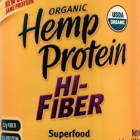 Most bodybuilders prefer to use animal-based protein products in their diets and supplements, and there’s a good reason for it: Animal proteins contain more balanced and greater amounts of essential amino acids, which are so-called because they cannot be synthesized in the body and must be supplied in the diet. From a muscle-building perspective, essential amino acids are the primary initiators of muscle protein synthesis. In fact, as little as 10 grams of essential amino acids are all that is required to promote muscle protein synthesis fully after resistance exercise.
Most bodybuilders prefer to use animal-based protein products in their diets and supplements, and there’s a good reason for it: Animal proteins contain more balanced and greater amounts of essential amino acids, which are so-called because they cannot be synthesized in the body and must be supplied in the diet. From a muscle-building perspective, essential amino acids are the primary initiators of muscle protein synthesis. In fact, as little as 10 grams of essential amino acids are all that is required to promote muscle protein synthesis fully after resistance exercise.
The most popular protein supplement favored by bodybuilders and athletes is whey protein. Whey has a high biological value because of its rich content of essential amino acids, particularly the branched-chain aminos, but that’s not the only thing that makes whey useful. Whey is rapidly digested, and its amino acid contents are released rapidly into the blood, which favors a higher rate of muscle protein synthesis. The other protein found in milk, casein, is more gradually absorbed over a course of seven hours and is thought to exert a greater anticatabolic effect in muscle than whey.
In addition to whey and casein mixtures, either in combination or separate, other protein supplements are available. Many of them use soy protein as their base. Soy has earned a reputation among bodybuilders as being nefarious because of its content of isoflavones, which are estrogenlike substances. Some suggest that the isoflavones can interfere with thyroid function and because of the estrogen-mimicking effect of soy isoflavones, interfere with testosterone production or exert estrogen effects in men. The truth is that the dose determines the poison. Smaller amounts of soy protein have been shown in various studies to be harmless to young men engaged in weight training.
Soy contains a complete spectrum of essential amino acids, which is rare for a vegetable protein. With the recent rise in price of whey proteins and the lower cost of soy, many companies are now including soy in their products.
Another protein source that is comparatively rare compared to milk proteins and soy is hemp. The scientific name for hemp is Cannabis sativa, which is also familiarly known as marijuana. Yes, marijuana is derived from hemp, which is the reason it’s against federal law to grow hemp plants in the United States, except in South Dakota. From the perspective of food supplements, hemp is sold as a protein powder and as a nutritive oil. Hemp oil is actually quite good, well balanced in fatty-acid content. But what about the protein?
A study published last year examined the protein content of hemp.1 Although there are different methods used to evaluate the biological value of protein foods, this study used the protein-digestion-corrected amino acid score, or PDCAAS, which is said to reflect how well a protein is digested and utilized by the body. The “body” in this case, however, wasn’t human, but instead reflected the growth potential provided by proteins on growing rats.
Hemp seed and its products contain all essential amino acids. That’s the good news. The bad news is that it’s a bit low in the amino acid lysine as well as leucine and tryptophane. The lower leucine is particularly problematic, since leucine, a branched-chain amino acid, is the primary amino involved in promoting muscle protein synthesis. The high content of leucine in whey is one of the reasons why whey rates at the top of most protein evaluation scales.
On the PDCAAS scale, hemp seed rates a 51, while hemp seed meal—the source of hemp protein powders—rates a 48. In contrast, casein rates 100 on the scale, while egg whites also rate 100. Beef follows with a 92 rating, matching that of soy protein. That alone makes you wonder about this method of rating proteins, since it rates beef, an animal protein, at the same level as soy, a plant protein. Not surprisingly, the PDCAAS was developed by Ralston Purina, a major producer of—you guessed it—soy! On this scale hemp is similar to beans in terms of protein value but lower than oats.
Even so, hemp is also rich in arginine, which is a precursor of nitric oxide, among other effects. Hemp protein contains gamma-linoleic acid as well, a fatty acid source linked to lower inflammation in the body. One study a few years ago showed that taking gamma linoleic acid helped to prevent the regain of fat following a diet. Overall, hemp must be considered a mediocre protein source at best; however, it may appeal to vegetarians. Perhaps if it still contained enough THC, the active ingredient in marijuana, it would be more popular, but that’s just speculation on my part. —Jerry Brainum
Editor’s note: Have you been ripped off by supplement makers whose products don’t work as advertised? Want to know the truth about them? Check out Natural Anabolics, available at JerryBrainum.com.
1 House, J., et al. (2010). Evaluating the quality of protein from hemp seed (Cannabis sativa) products through the use of the protein-digestibility-corrected amino acid score method. J Agr Food Chem. 58:11801-11807.




















You must be logged in to post a comment Login